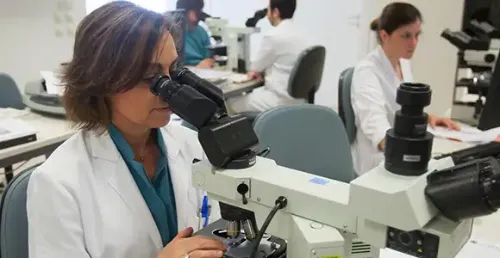Amyloidosis
"It is essential to correctly identify the type of protein that is being deposited as amyloid material, since the treatment differs depending on it".
DR. RAMÓN LECUMBERRI
CODIRECTOR. HEMATOLOGY AND HEMOTHERAPY DEPARTMENT

What is amyloidosis?
Amyloidoses are a heterogeneous group of diseases consisting of the anomalous folding of a precursor protein that ends up being deposited in the form of fibrillar structures in various organs and systems (heart, kidney, liver, intestine, nervous system, etc.), altering their function.
More than 30 proteins have been described as being involved in the appearance of the different variants of amyloidosis, but the most frequent are AL amyloidosis (due to immunoglobulin light chains), ATTR (due to instability of transthyretin due to mutations or associated with age) and AA (associated with chronic inflammatory disorders).
It is essential to correctly identify the type of protein responsible for amyloid deposition, as treatments differ according to the type of amyloidosis.

What are the symptoms of amyloidosis?
Symptoms are nonspecific and derive mainly from the dysfunction of the various organs affected by the deposits. Early diagnosis is important to avoid irreversible damage to these organs.
When there is cardiac involvement, the symptomatology is that of heart failure: fatigue, peripheral edema, difficulty in making small efforts. In more advanced cases, syncope may occur. There is also an increased risk of arrhythmias.
In renal involvement the characteristic is the loss of proteins, especially albumin, in the urine (proteinuria). The decrease of albumin in the blood favors the appearance of generalized edema.
Amyloid deposits in the gastrointestinal tract can cause alterations in intestinal motility and food malabsorption.
Deposits of amyloid in the peripheral nervous system occasionally lead to a sensory disorder with tingling and a cramping sensation.
In some amyloidoses deposits in soft tissues are frequent, manifesting as carpal tunnel syndrome (often bilateral), macroglossia, capillary fragility (periorbital purpura is characteristic).
What are the most common symptoms?
- Mild Proteinuria
- Cardiomegalia
- Heart failure
- Alterations in intestinal motility
Do you have any of these symptoms?
You may have amyloidosis
What are the causes of amyloidosis?
Again, it depends on the type of amyloidosis.
- AL: the origin lies in the abnormal production of an immunoglobulin fragment (kappa or lambda light chain) by plasma cells in the bone marrow.
- AA: is caused by an increase in serum amyloid A protein concentration as a consequence of chronic inflammatory processes.
- ATTR: is related to instability of the transthyretin protein, synthesized in the liver, due to mutations in its gene (mutated or hereditary ATTR) or changes with age (native ATTR).
In addition, there are other much more infrequent amyloidoses, some of them of hereditary character due to mutations in the genes of fibrinogen, lysozyme, apolipoprotein A-I, etc.
What is the prognosis of amyloidosis?
The prognosis is highly variable (ranging from a few months to many years) depending on the type of amyloidosis and the severity of involvement, especially cardiac involvement. For this reason, early diagnosis is essential to allow early treatment.
In recent years there has been a notable increase in the survival of patients with AL and ATTR amyloidosis due to the development of new therapies.
How is amyloidosis diagnosed?

In most cases a biopsy of affected tissue is required to demonstrate the presence of amyloid deposits by Congo Red staining.
Although a renal or cardiac biopsy is sometimes required, most often a biopsy of abdominal fat, lip or bone marrow is obtained at the outset.
In selected patients with signs of cardiac involvement by amyloidosis on echocardiography or MRI, and who do not have monoclonal immunoglobulin in blood or urine, cardiac scintigraphy may be sufficient for the diagnosis of ATTR, without the need for biopsy.
How is amyloidosis treated?
The Clinic's Amyloidosis Unit is made up of specialists in Hematology, Cardiology, Nephrology and Neurology who work as a team to offer patients a comprehensive and individualized treatment, according to their needs.
Treatment is very different depending on the type of amyloidosis.
- AL: Treatments are aimed at stopping the production of the pathological light chain by attacking the plasma cells in the bone marrow responsible for its production. If the production of new amyloid is prevented, the affected organs have a chance of functional improvement. Bortezomib, cyclophosphamide and dexamethasone combination regimens are usually used initially. Recently the benefit of adding a new drug, daratumumab, in combination with the previous drugs has been shown. In selected patients, autologous hematopoietic stem cell transplantation may be indicated.
- ATTRm: some drugs that stabilize transthyretin or block its hepatic synthesis have been approved, although their use is restricted to specific scenarios.
- ATTRnative: the most important thing in this case is supportive cardiac treatment. The role of the same drugs used for the hereditary variant is being evaluated.
- AA: treatment is directed at the underlying inflammatory disorder.
Solid organ transplantation may also be considered in some cases.
At the Clinica we have the latest therapeutic advances and participate in multiple clinical trials in the field of AL amyloidosis and ATTR.
What clinical trials do we have on Amyloidosis?
Where do we treat it?
IN NAVARRE AND MADRID
The Hematology and Hemotherapy Service of the
at the Clínica Universidad de Navarra
The Hematology Service of the Clinic, formed by specialists of recognized national and international prestige, has integrated molecular diagnostic techniques and the use of new personalized treatments in its assistance work, allowing a more precise and fast diagnosis of the hematological diseases.
The joint work of the medical staff and the researcher facilitates the development and application of the new treatments and at the same time the precise evaluation of the result of the treatments.

Why at the Clinica?
- Experts in the development of Cellular Therapy treatments.
- International reference center in lymphomas, multiple myeloma and monoclonal gammopathies.
- Experts in the diagnosis and treatment of hemorrhagic and thrombotic problems.
Our team of professionals



















